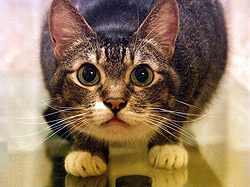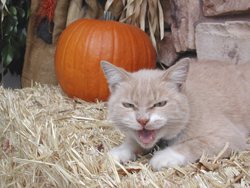Cats are unquestionably smart creatures. Their intelligence, however, is not a matter of understanding complex human ideas, but how to get the food, attention, play and care they so need and desire. In other words, cats know how to “work the system” and use their natural survival skills, even in a domestic environment.
Of course, some cats are bound to be better problem solvers than others. How do you know if you’ve got a brainy feline? There are no scientific tests to measure feline IQ. You can, however, get a pretty good idea of how smart your cat is just by observing him. Here are some questions to help you assess your cat’s intelligence:
1. When you open a can of cat food with an electric can opener, what does your cat do?
a) Runs and hides under the bed
b) Looks up briefly, then gets back to napping
c) Immediately races into the kitchen
2. When you get out the pet carrier, what does your cat do?
a) Gives it a quick glance
b) Runs away, but will come back if offered a treat
c) Hides and won’t come out
3. How often does your cat persuade you to get out of bed early to fix her breakfast?
a) Never
b) Once in a while
c) Every day
4. Has your cat ever learned to do something just by watching you do it, such as how to open a cupboard door or turn off a light switch?
a) No
b) Yes, one or two easy procedures like how to open the box of cat treats
c) Yes. There are many things my cat has learned to do just by observing me.
5. If you come home at the same time every day, does your cat wait for your arrival, apparently aware that you have a regular return time?
a) No
b) Yes. He’s usually waiting for me by the door.
c) Yes. As soon as I walk in, he escorts me to the kitchen so I can get him dinner.
6. If a piece of food or a cat toy is out of your cat’s reach or trapped behind an object, what does your cat do?
a) Paws at it once or twice, but gives up if that doesn’t work
b) Tries to retrieve the item with her mouth and one of her paws and gives up after several failed attempts
c) Uses both of her paws and her mouth to grasp the item and won’t quit until she’s successful
7. Does your cat enjoy playing games with you?
a) Not at all
b) Occasionally
c) Very much so — especially challenging games like hide-and-go-seek
8. If your cat sees a bird outside the window, what does he do?
a) Bangs his head against the glass, trying to reach the bird
b) Paws madly at the window and yowls until I shut the blinds
c) Races to the door and meows until I let him outside
9. If you’ve ever moved your cat’s feeding dishes or litterbox from one part of the house to another, how long did it take her to get used to the new location?
a) Several weeks
b) A few days
c) One day or less
10. When you call your cat’s name, what does he do?
a) Nothing
b) Looks my way for a second or turns his ears in my direction
c) Immediately runs toward me
11. Does your cat ever get bored with her toys and create her own amusements using your socks, the goldfish bowl, the tassels on your drapes, etc.?
a) My cat’s not very interested in toys.
b) Sometimes
c) Almost daily
12. If a guest teased or pestered your cat in the past, does your cat single out that person as trouble — for example, by avoiding that person but allowing other guests to handle him?
a) No. My cat acts the same toward everyone.
b) He does prefer some people over others, but there’s no clear reason for his preferences.
c) Most definitely! My cat remembers who gave him grief and does not forget.
13. How often do you come home from work to discover that your cat has gotten into mischief while you were away?
a) Never
b) Now and then
c) All the time
14. While petting your cat, does she let you know where she most wants to be stroked and for how long?
a) No. She becomes extremely relaxed and doesn’t care where or how long she’s being stroked.
b) She purrs if she likes what I’m doing and growls or hisses if I pet her where she doesn’t want to be touched.
c) She moves around to make it easier for me to pet certain parts of her body.
15. What happens when you try to teach your cat a trick?
a) My cat never figures out what I’m trying to teach him.
b) After several training sessions, my cat is pretty good at it.
c) My cat masters the trick after one short training session.
16. After you’ve taught your cat a trick, will she still remember how to do it a month from now if you haven’t done any refresher sessions?
a) Not likely
b) Probably
c) Definitely
17. When your cat wants something from you, what does he do?
a) Purrs
b) Meows a little more loudly than usual
c) Makes a variety of vocalizations, depending on what he wants
18. How often does your cat coax you into playtime?
a) Rarely
b) Sometimes
c) Frequently
19. How does your cat react when the litterbox needs cleaning?
a) Goes in the same spot until I notice the mountain inside the litterbox
b) Starts using the planters for a litterbox or goes outside the litter pan
c) Goes outside the litterbox and meows loudly to get the point across
20. When your cat’s food bowl is empty, what does he do to remedy the situation?
a) Sits quietly in the cat tree and waits for me to feed him
b) Leaps onto my lap and meows until I realize he’s hungry
c) Opens the cupboard where the bag of cat food is stored and rips it open
SCORING
Give your cat one point for every “c” answer. Deduct one point for every “a” answer. A “b” answer is a neutral response and doesn’t affect the score. Tally up the total number of points, and grade your cat according to the scale below.
Less than 5 points: Smarts aren’t your kitty’s strongest suit, but chances are that your cat is a wonderful companion, even if he doesn’t know how to open up the pantry to get out a treat!
6 – 15 points: When it comes to bell curves, your feline’s where most cats are: right in the middle. Your cat has average intelligence and can learn a few tricks, but has no desire to take apart the cat water fountain and reassemble it.
15 – 20 points: You may just be living with a feline Einstein! Your cat is extremely intelligent and continually amazes you with new tricks. Your cat also knows how to get you to do things her way. You’re going to need to be pretty crafty yourself if you want to outsmart your cat!
Rebecca Sweat is a freelance writer specializing in pet and family topics. She lives in the Dallas area with her husband, two sons and many pets




![DSC01527[1]](https://interlachenanimalhospital.com/wp-content/uploads/2012/04/DSC0152711-300x225.jpg)


 mains the scourge of veterinary medicine.
mains the scourge of veterinary medicine.